Facile Synthesis of Hollow Fe3O4-rGO Nanocomposites for the Electrochemical Detection of Acetaminophen
Abstract
1. Introduction
2. Materials and Methods
2.1. Materials
2.2. Preparation of Hollow Fe3O4 Nanoparticles
2.3. Preparation of rGO
2.4. Preparation of Magnetic Fe3O4-rGO/GCE
2.5. Characterization
2.6. Electrochemical Measurements
3. Results and Discussion
4. Conclusions
Supplementary Materials
Author Contributions
Funding
Data Availability Statement
Conflicts of Interest
References
- Murugan, E.; Poongan, A.; Dhamodharan, A. Electrochemical sensing of acetaminophen, phenylephrine hydrochloride and cytosine in drugs and blood serum samples using β-AgVO3/ZrO2@g-C3N4 composite coated GC electrode. J. Mol. Liq. 2022, 348, 118447. [Google Scholar] [CrossRef]
- Wang, P.; Yuan, X.; Cui, Z.; Xu, C.; Sun, Z.; Li, J.; Liu, J.; Tian, Y.; Li, H. A nanometer-sized graphite/boron-doped diamond electrochemical sensor for sensitive detection of acetaminophen. ACS Omega 2021, 6, 6326–6334. [Google Scholar] [CrossRef] [PubMed]
- Sakthivel, M.; Sivakumar, M.; Chen, S.M.; Hou, Y.S.; Veeramani, V.; Madhu, R.; Miyamoto, N. A facile synthesis of Cd(OH)2-rGO nanocomposites for the practical electrochemical detection of acetaminophen. Electroanal 2016, 28, 1–8. [Google Scholar] [CrossRef]
- Khashij, M.; Mehralian, M.; Chegini, Z.G. Degradation of acetaminophen (ACT) by ozone/persulfate oxidation process: Experimental and degradation pathways. Pigment. Resin Technol. 2020, 49, 363–368. [Google Scholar] [CrossRef]
- Haghshenas, E.; Madrakian, T.; Afkhami, A. A novel electrochemical sensor based on magneto Au nanoparticles/carbon paste electrode for voltammetric determination of acetaminophen in real samples. Mater. Sci. Eng. C 2015, 57, 205–214. [Google Scholar] [CrossRef] [PubMed]
- Abdelaleem, E.A.; Abdelwahab, N.S. Validated stability indicating RP-HPLC method for determination of paracetamol, methocarbamol and their related substances. Anal. Methods 2013, 5, 541–545. [Google Scholar] [CrossRef]
- Pietruk, K.; Gbylik-Sikorska, M.; Ebkowska-Wieruszewska, B.; Gajda, A.; Jedziniak, P. Development of a multimatrix UHPLC-MS/MS method for the determination of paracetamol and its metabolites in animal tissues. Molecules 2021, 26, 2046. [Google Scholar] [CrossRef]
- Taylor, R.R.; Hoffman, K.L.; Schniedewind, B.; Clavijo, C.; Galinkin, J.L.; Christians, U. Comparison of the quantification of acetaminophen in plasma, cerebrospinal fluid and dried blood spots using high-performance liquid chromatography-tandem mass spectrometry. J. Pharm. Biomed. Anal. 2013, 83, 1–9. [Google Scholar] [CrossRef]
- Caruso, T.J.; Trivedi, S.; Chadwick, W.; Gaskari, S.; Wang, E.; Marquez, J.; Lagasse, S.; Bailey, M.; Shea, K. A quality improvement project to reduce combination acetaminophen-opioid prescriptions to pediatric orthopedic patients. Pediatr. Qual. Saf. 2020, 5, e291. [Google Scholar] [CrossRef]
- Kang, X.; Wang, J.; Wu, H.; Liu, J.; Aksay, I.A.; Lin, Y. A graphene-based electrochemical sensor for sensitive detection of paracetamol. Talanta 2010, 81, 754–759. [Google Scholar] [CrossRef]
- Bui, M.P.N.; Li, C.A.; Han, K.N.; Pham, X.H.; Seong, G.H. Determination of acetaminophen by electrochemical co-deposition of glutamic acid and gold nanoparticles. Sens. Actuators B Chem. 2012, 174, 318–324. [Google Scholar] [CrossRef]
- Dong, P.; Li, N.; Zhao, H.; Cui, M.; Zhang, C.; Han, H.; Ren, J. POMs as active center for sensitively electrochemical detection of bisphenol A and acetaminophen. Chem. Res. Chin. Univ. 2019, 35, 592–597. [Google Scholar] [CrossRef]
- Song, Y.; Li, J.; Zhang, Y.; Zhao, J.; Li, Y. Preparation of mesoporous carbon nanospheres and its application in electrochemical detection of acetaminophen. J. Minnan Nor. U. Nat. Sci. 2019, 32, 44–54. [Google Scholar]
- Yi, W.; Han, C.; Li, Z.; Guo, Y.; Dong, C. A strategy of electrochemical simultaneous detection of acetaminophen and levofloxacin in water based on g-C3N4 nanosheet-doped graphene oxide. Environ. Sci. Nano 2021, 8, 258–268. [Google Scholar] [CrossRef]
- Marzouqi, F.A.; Selvaraj, R.; Kim, Y. Rapid photocatalytic degradation of acetaminophen and levofloxacin using g-C3N4 nanosheets under solar light irradiation. Mater. Res. Express 2019, 6, 125538. [Google Scholar] [CrossRef]
- Liang, J.; Lou, Q.; Wu, W.; Wang, K.; Xuan, C. NO2 gas sensing performance of a VO2(B) ultrathin vertical nanosheet array: Experimental and DFT investigation. ACS Appl. Mater. Interfaces 2021, 13, 31968–31977. [Google Scholar] [CrossRef]
- Maleh, H.K.; Ahanjan, K.; Taghavi, M.; Ghaemy, M. A novel voltammetric sensor employing zinc oxide nanoparticles and a new ferrocene-derivative modified carbon paste electrode for determination of captopril in drug samples. Anal. Methods 2016, 8, 1780–1788. [Google Scholar] [CrossRef]
- Yi, W.W.; Li, Z.P.; Dong, C.; Li, H.W.; Li, J.F. Electrochemical detection of chloramphenicol using palladium nanoparticles decorated reduced graphene oxide. Microchem. J. 2019, 148, 774–783. [Google Scholar] [CrossRef]
- Jin, G.; Wang, S.M.; Chen, W.L.; Qin, C.; Su, Z.M.; Wang, E.B. A photovoltaic system composed of a keplerate-type polyoxometalate and a water-soluble poly (p-phenylenevinylene) derivative. J. Mater. Chem. A 2013, 1, 6727–6730. [Google Scholar] [CrossRef]
- Karthik, R.; Kumar, J.V.; Chen, S.M.; Karuppiah, C.; Cheng, Y.H.; Muthuraj, V. A study of electrocatalytic and photocatalytic activity of cerium molybdate nanocubes decorated graphene oxide for the sensing. ACS Appl. Mater. Interfaces 2017, 9, 6547–6559. [Google Scholar] [CrossRef]
- Liang, J.; Yu, L.; Wang, Y.; Xue, T.; Lei, D.; Wang, Z.; Li, X. Periodic arrays of 3D AuNP-Capped VO2 shells and their temperature-tunable SERS performance. Adv. Opt. Mater. 2022, 10, 2101615. [Google Scholar] [CrossRef]
- Wang, Y.; Sheng, W.; Wu, J.; Xu, J.; Song, K. Non-enzymatic electrochemical detection of dopamine in blood serum based on porous nitrogen-doped graphene/Fe3O4 nanocomposites. Micro Nano Lett. 2022, 15, 774–778. [Google Scholar] [CrossRef]
- Fayazi, M.; Taher, M.A.; Afzali, D.; Mostafavi, A. Fe3O4 and MnO2 assembled on halloysite nanotubes: A highly efficient solid-phase extractant for electrochemical detection of mercury (II) ions. Sens. Actuators B Chem. 2016, 228, 1–9. [Google Scholar] [CrossRef]
- Li, H.; Kou, B.; Yuan, Y.; Chai, Y.; Yuan, R. Porous Fe3O4@COF-Immobilized gold nanoparticles with excellent catalytic performance for sensitive electrochemical detection of ATP. Biosens. Bioelectron. 2022, 197, 113758. [Google Scholar] [CrossRef]
- Xu, G.; Zhang, M.; Yu, X. Electrochemical detection of nitrite in food based on poly (3,4-ethylenedioxythiophene) doped with Fe3O4 nanoparticles loaded carboxylated nanocrystalline cellulose. Acta Chim. Slov. 2018, 65, 502–511. [Google Scholar] [CrossRef]
- Yang, Z.; Yang, J.P.; Wang, J.; Yao, S.W.; Liu, G. Preparation of hollow Fe3O4 nanospheres & spongy carbon composite and its characterization of electrochemical performance. J. Mater. Eng. 2018, 46, 43–50. [Google Scholar]
- Wang, Y. Hollow Fe3O4 spheres as efficient sulfur host for advanced electrochemical energy storage. Int. J. Electrochem. Sci. 2019, 14, 1416–1422. [Google Scholar] [CrossRef]
- Zhang, L.; Zhang, H.; Chen, Q.; Zhai, C. Plasmon enhanced photo-assisted electrochemical detection of bisphenol A based on Au decorated La2Ti2O7/RGO nanosheets. Surf. Interfaces 2021, 26, 101331. [Google Scholar] [CrossRef]
- Shen, C.; Wang, L.; Zhou, A.; Bo, W.; Wang, X.; Lian, W.; Hu, Q.; Qin, G.; Liu, X. Synthesis and electrochemical properties of two-dimensional RGO/Ti3C2Tx nanocomposites. Nanomaterials 2018, 8, 80. [Google Scholar] [CrossRef] [PubMed]
- Gogoi, D.; Das, M.R.; Ghosh, N.N. CoFe2O4 hollow spheres-decorated three-dimensional rGO sponge for highly efficient electrochemical charge storage devices. ACS Omega 2022, 7, 11305–11319. [Google Scholar] [CrossRef]
- Sun, P.; Xu, K.; Guang, S.; Xu, H. Controlling assembly-induced single layer RGO to achieve highly sensitive electrochemical detection of Pb(II) via synergistic enhancement. Microchem. J. 2021, 162, 105883. [Google Scholar] [CrossRef]
- Hu, H.; Lu, W.; Liu, X.; Meng, F.; Zhu, J. A high-response electrochemical As(III) sensor using Fe3O4-rGO nanocomposite materials. Chemosensors 2021, 9, 150. [Google Scholar] [CrossRef]
- Shi, L.; He, Y.; Hu, Y.; Wang, X.; Jiang, B.; Huang, Y. Synthesis of size-controlled hollow Fe3O4 nanospheres and their growth mechanism. Particuology 2020, 49, 16–23. [Google Scholar] [CrossRef]
- Saha, S.; Jana, M.; Samanta, P.; Murmu, N.C.; Lee, J.H. Hydrothermal synthesis of Fe3O4/RGO composites and investigation of electrochemical performances for energy storage applications. RSC Adv. 2014, 4, 44777–44785. [Google Scholar] [CrossRef]
- Wang, Y.; Li, Y.; Tang, L.; Lu, J.; Li, J. Application of graphene-modified electrode for selective detection of dopamine. Electrochem. Commun. 2009, 11, 889–892. [Google Scholar] [CrossRef]
- Shen, L.; Li, B.; Qiao, Y.; Song, J. Monodisperse Fe3O4/SiO2 and Fe3O4/SiO2/PPy core-Shell composite nanospheres for IBU loading and release. Materials 2019, 12, 828. [Google Scholar] [CrossRef]
- Li, B.; Qiao, Y.; An, J.; Shen, L.; Ma, Q.; Guo, Y. Synthesis, characterisation, and evaluation of core-shell Fe3O4/SiO2/polypyrrole composite nanoparticles. Micro Nano Lett. 2018, 13, 902–906. [Google Scholar] [CrossRef]
- Gunasekarana, S.; Thanrasub, K.; Manikandanc, A.; Durka, M.; Dinesh, A.; Anand, S.; Shankar, S.; Slimani, Y.; Almessiere, M.A.; Baykal, A. Structural, fabrication and enhanced electromagnetic wave absorption properties of reduced graphene oxide (rGO)/zirconium substituted cobalt ferrite (Co0.5Zr0.5Fe2O4) nanocomposites. Phys. B 2021, 605, 412784. [Google Scholar] [CrossRef]
- Alshammari, A.S.; Halim, M.M.; Yam, F.K.; Kaus, N.H.M. Synthesis of Titanium Dioxide (TiO2)/Reduced Graphene Oxide (rGO) thin film composite by spray pyrolysis technique and its physical properties. Mater. Sci. Semicond. Process. 2020, 116, 105140. [Google Scholar] [CrossRef]
- Saha, S.; Jana, M.; Khanra, P.; Samanta, P.; Koo, H.; Murmu, N.C.; Kuila, T. Band gap engineering of boron nitride by graphene and its application as positive electrode material in asymmetric supercapacitor device. ACS Appl. Mater. Interfaces 2015, 7, 14211–14222. [Google Scholar] [CrossRef]
- Abbas, M.; Abdel-Hamed, M.O.; Chen, J. Efficient one-pot sonochemical synthesis of thickness-controlled silica-coated superparamagnetic iron oxide (Fe3O4/SiO2) nanospheres. Appl. Phys. A 2017, 123, 775. [Google Scholar] [CrossRef]
- Li, S.J.; Du, J.M.; Chen, J.; Mao, N.N.; Zhang, M.J.; Pang, H. Electrodeposition of cobalt oxide nanoparticles on reduced graphene oxide: A two-dimensional hybrid for enzyme-free glucose sensing. J. Solid State Electrochem. 2014, 18, 1049–1056. [Google Scholar] [CrossRef]
- Feng, X.; Cheng, H.; Pan, Y.; Zheng, H. Development of glucose Biosensors based on nanostructured graphene-conducting polyaniline composite. Biosens. Bioelectron. 2015, 70, 411–417. [Google Scholar] [CrossRef] [PubMed]
- Wu, S.; Su, F.; Dong, X.; Ma, C.; Pang, L.; Peng, D.; Wang, M.; He, L.; Zhang, Z. Development of glucose biosensors based on plasma polymerization-assisted nanocomposites of polyaniline, tin oxide, and three-dimensional reduced graphene oxide. Appl. Surf. Sci. 2017, 401, 262–270. [Google Scholar] [CrossRef]
- Hao, Y.; Fang, M.; Xu, C.; Ying, Z.; Wang, H.; Zhang, R.; Cheng, H.M.; Zeng, Y. A graphene-laminated electrode with high glucose oxidase loading for highly-sensitive glucose detection. J. Mater. Sci. Technol. 2021, 66, 57–63. [Google Scholar] [CrossRef]
- Li, Z.; Li, Q.; Jiang, R.; Qin, Y.; Luo, Y.; Li, J.; Kong, W.; Yang, Z.; Huang, C.; Qu, X.; et al. An electrochemical sensor based on a MOF/ZnO composite for the highly sensitive detection of Cu(II) in river water samples. RSC Adv. 2022, 12, 5062–5071. [Google Scholar] [CrossRef]
- Zhu, K.; Cai, X.; Luo, Y.; Liu, B.; Zhang, Q.; Hu, T.; Liu, Z.; Wu, H.; Zhang, D. Facile synthesis of flower-like CePO4 with a hierarchical structure for the simultaneous electrochemical detection of dopamine, uric acid and acetaminophen. New J. Chem. 2022, 46, 4611–4619. [Google Scholar] [CrossRef]
- Wang, W.; Zhao, J.; Sun, Y.; Zhang, H. Facile synthesis of g-C3N4 with various morphologies for application in electrochemical detection. RSC Adv. 2019, 9, 7737–7746. [Google Scholar] [CrossRef]
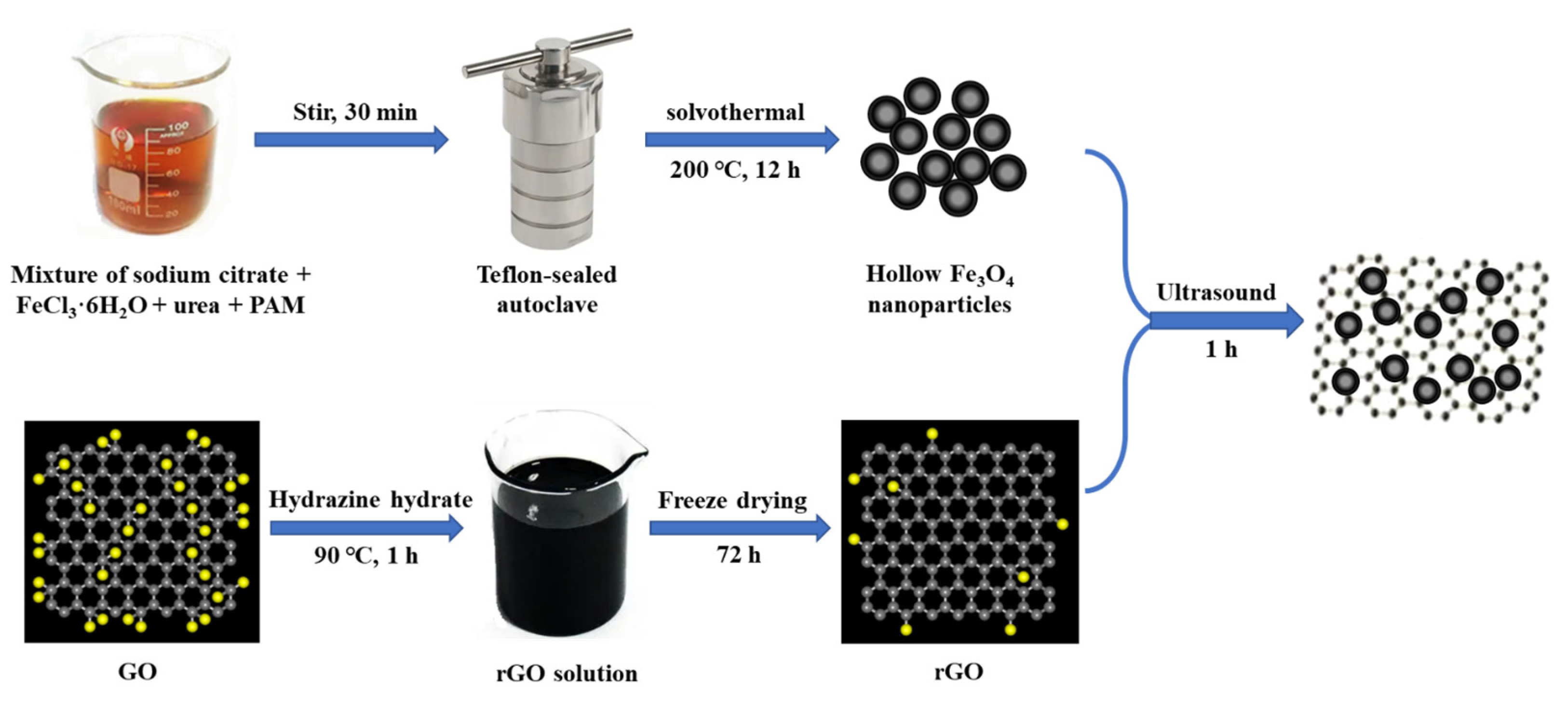
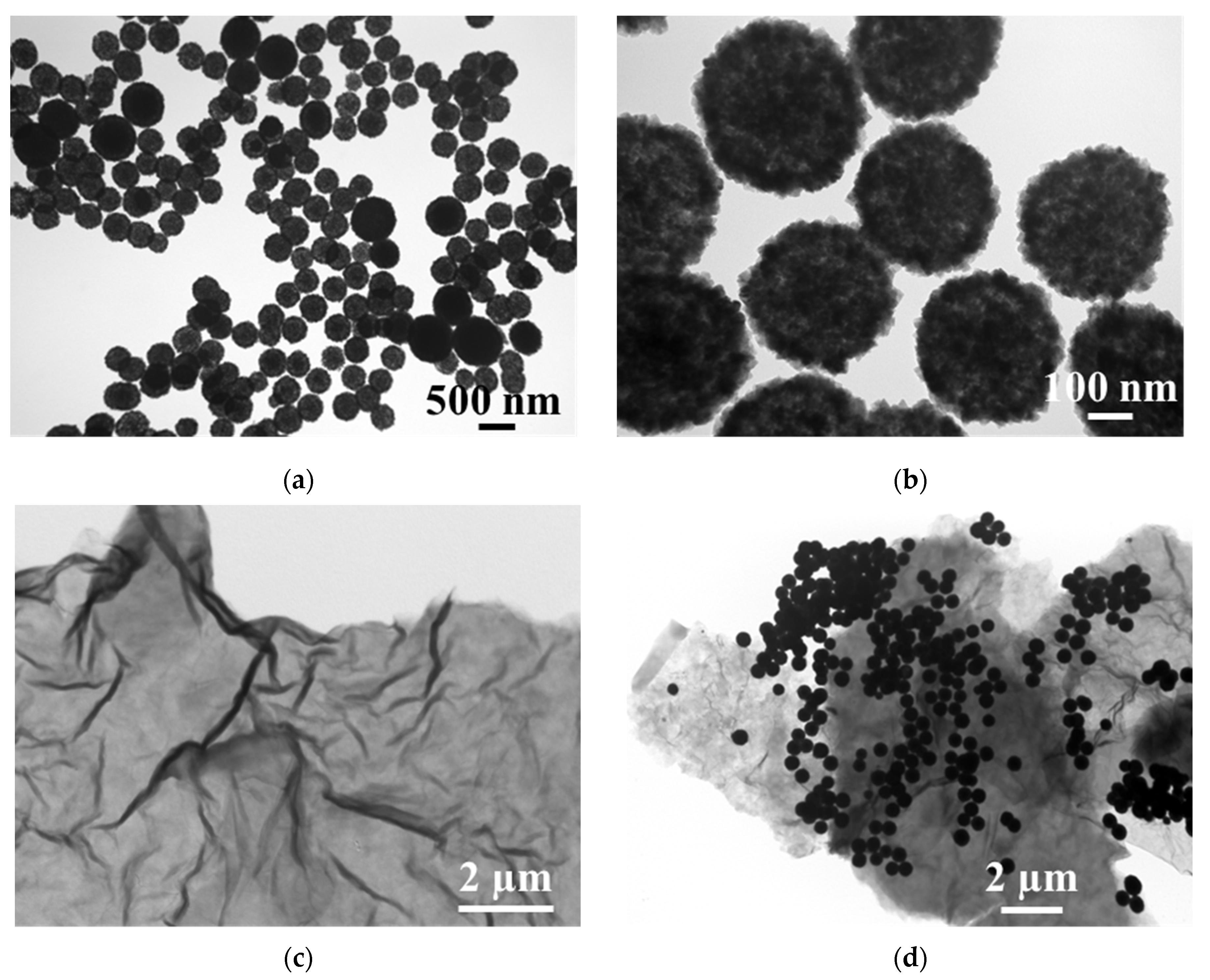
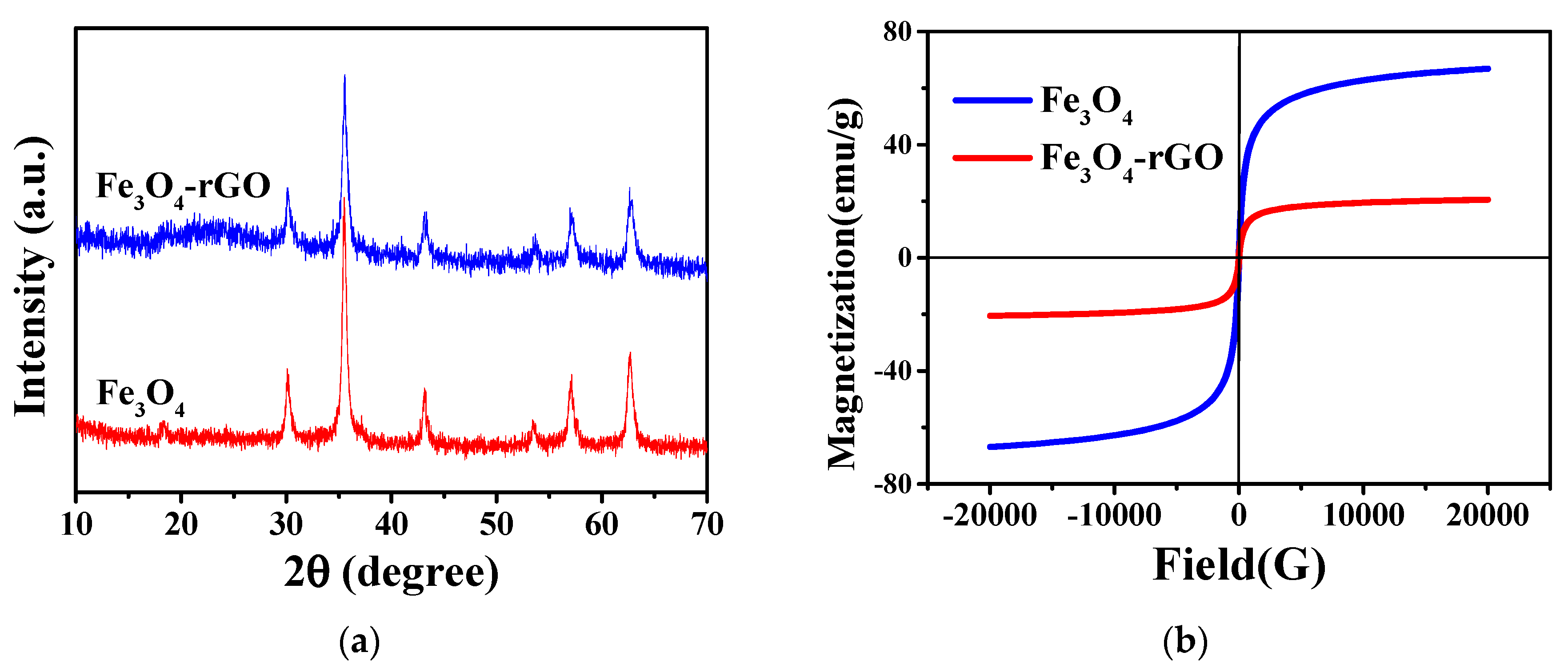
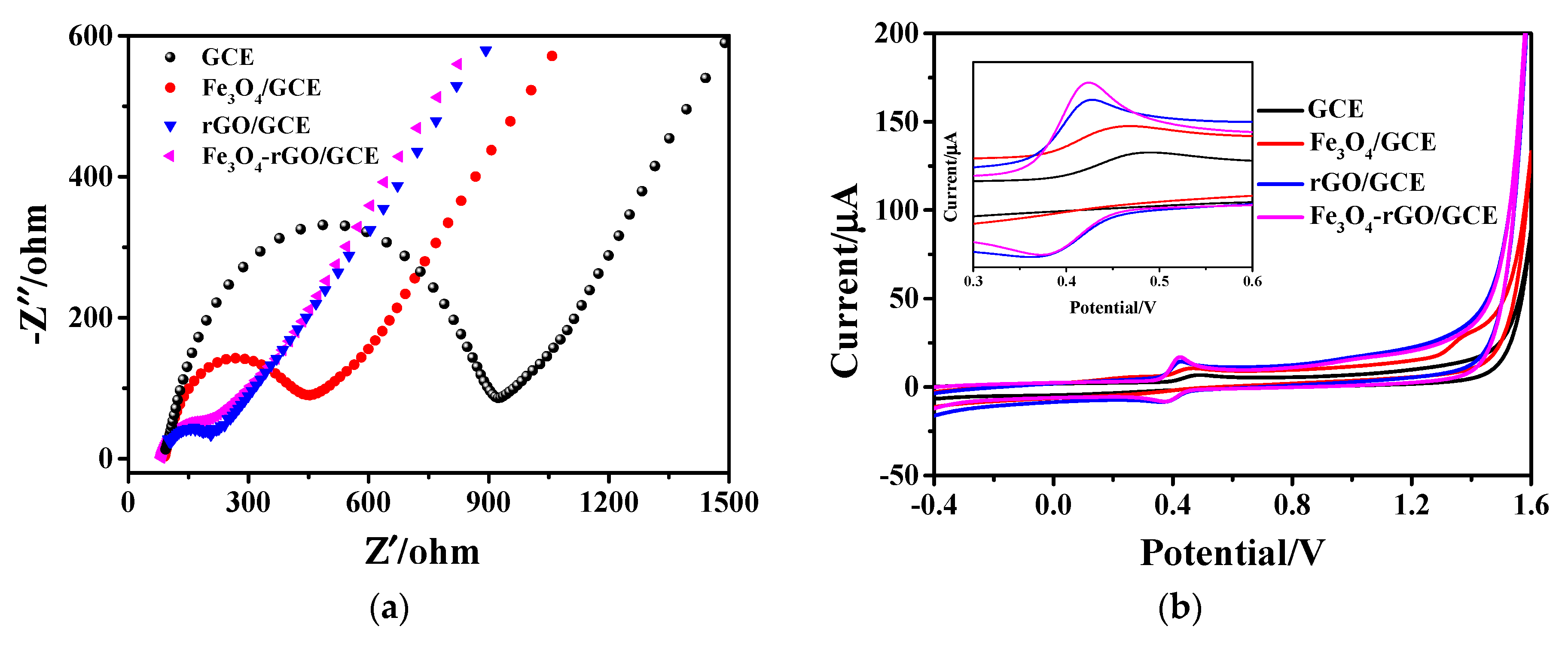
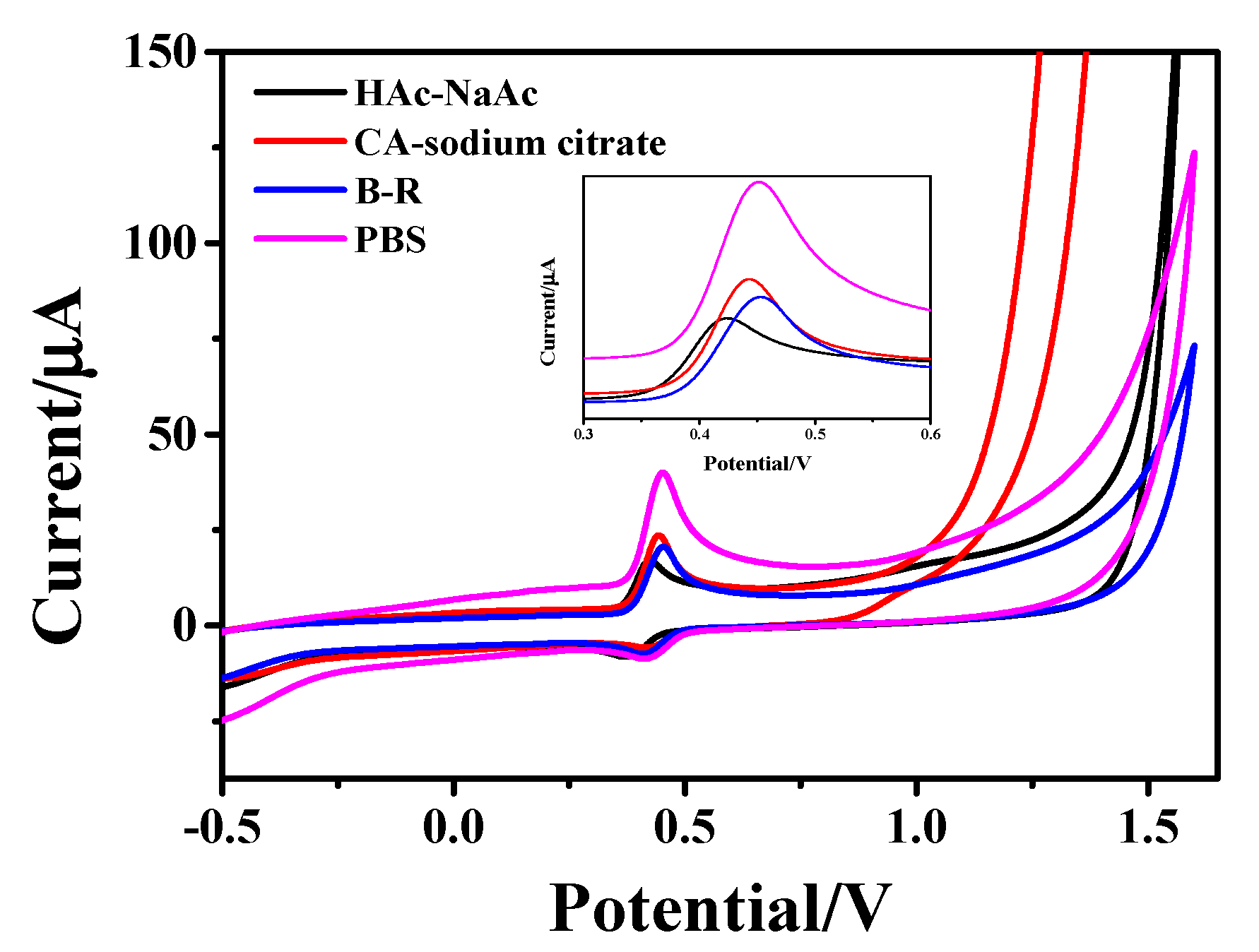
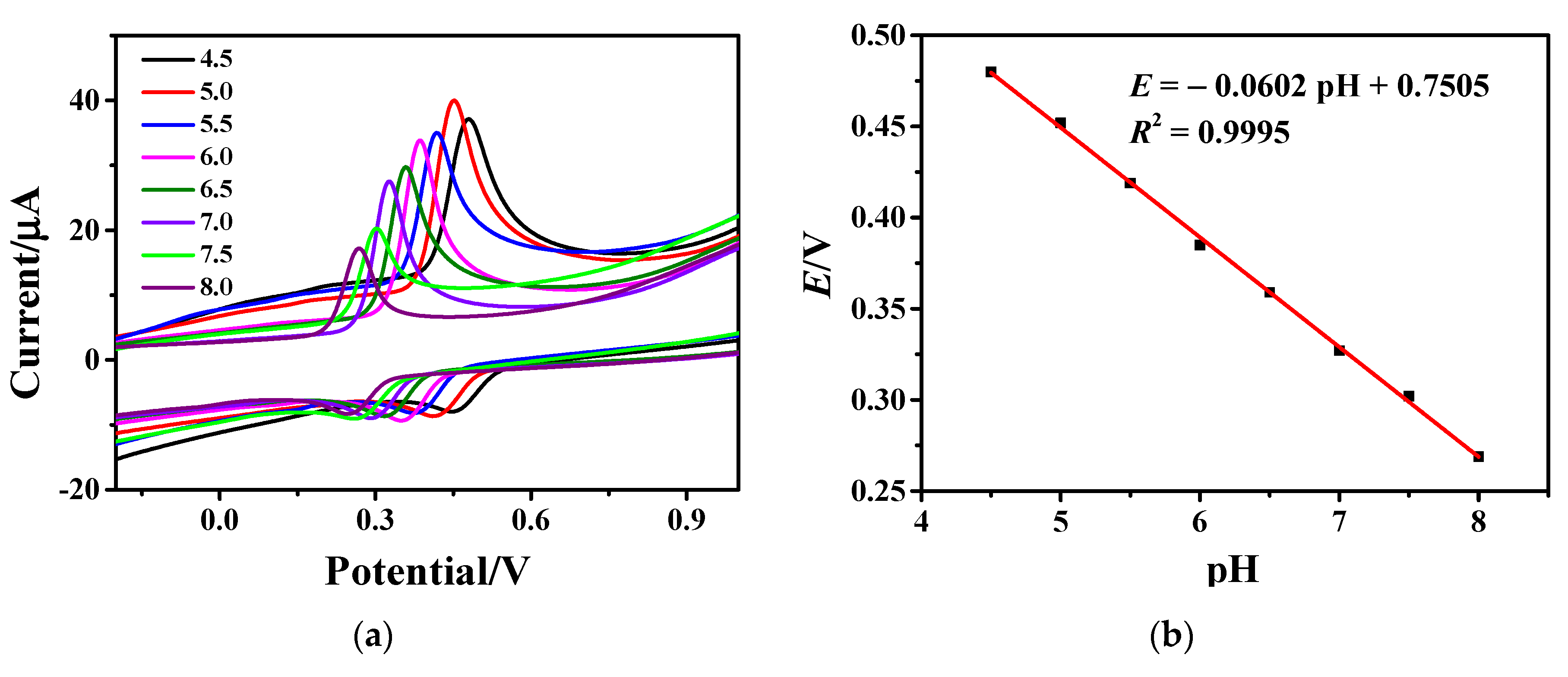
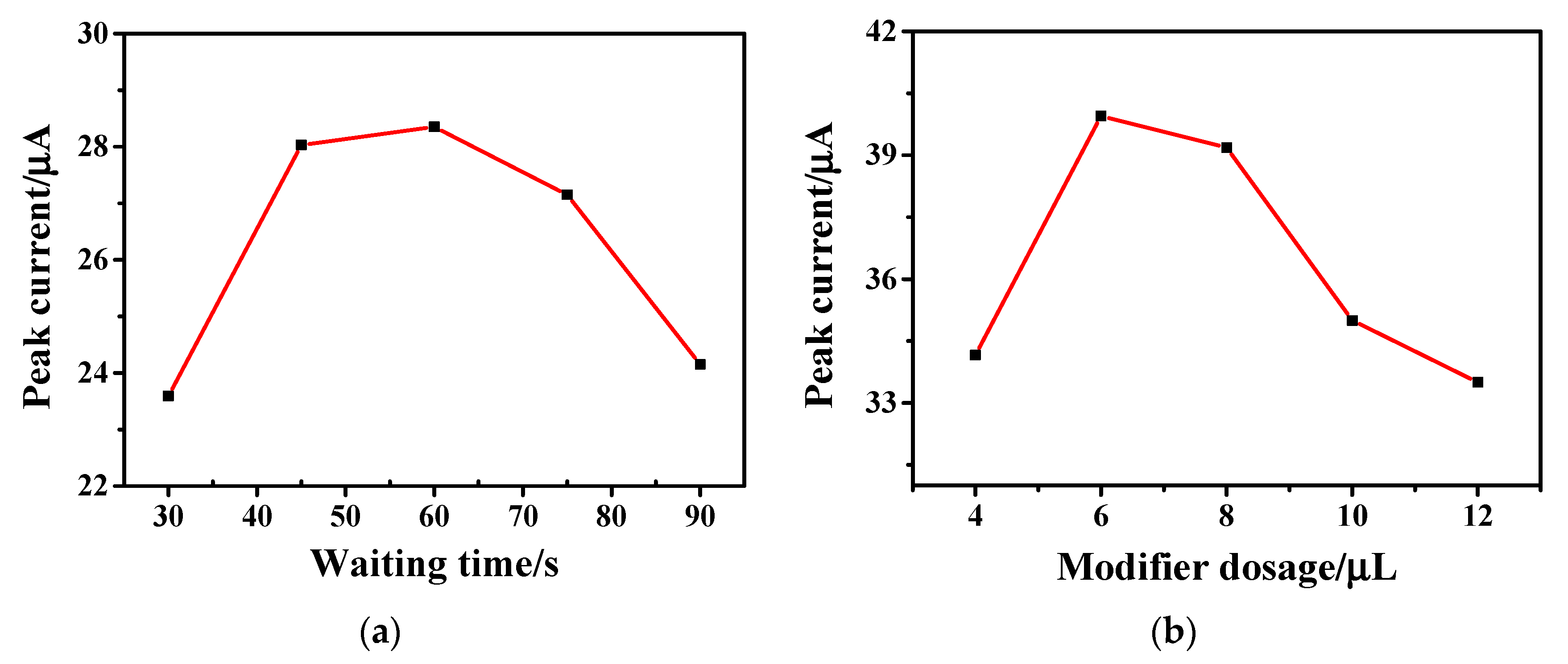
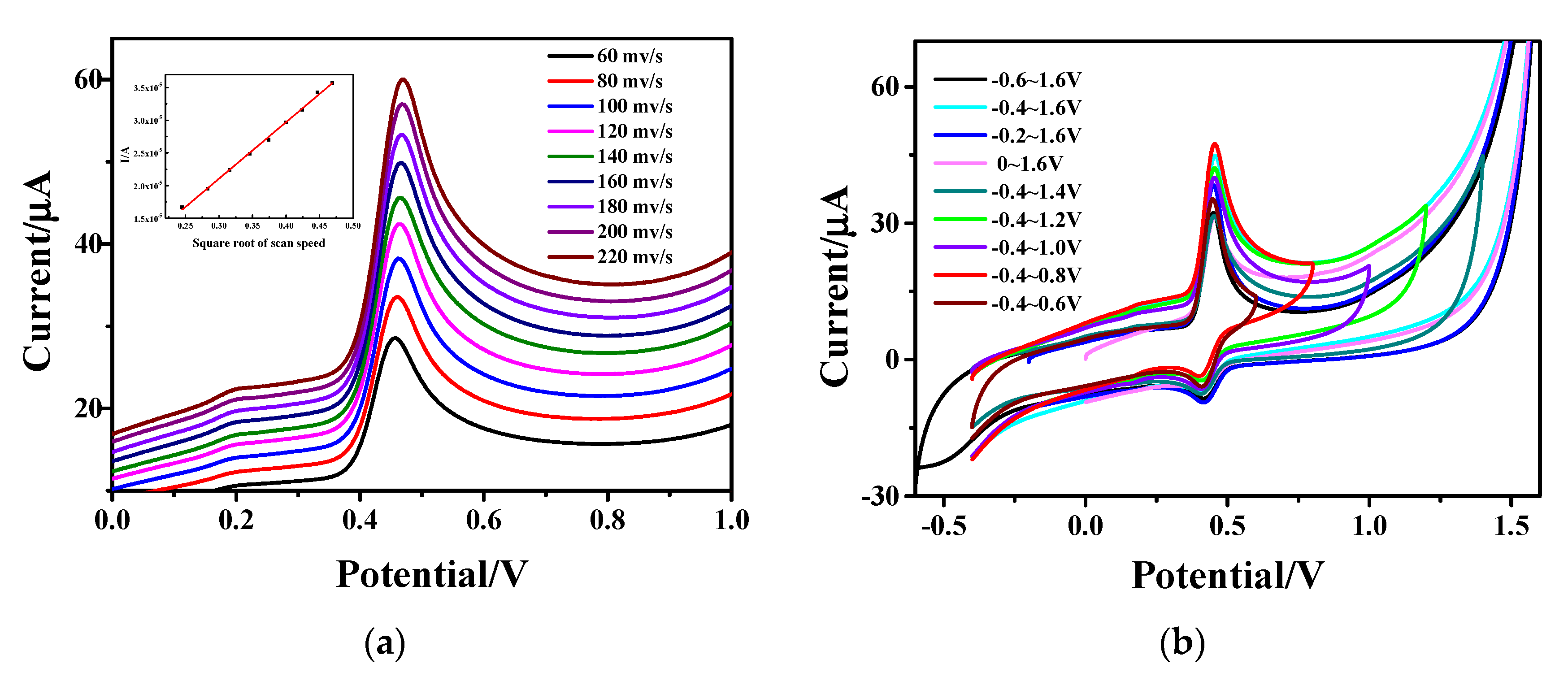
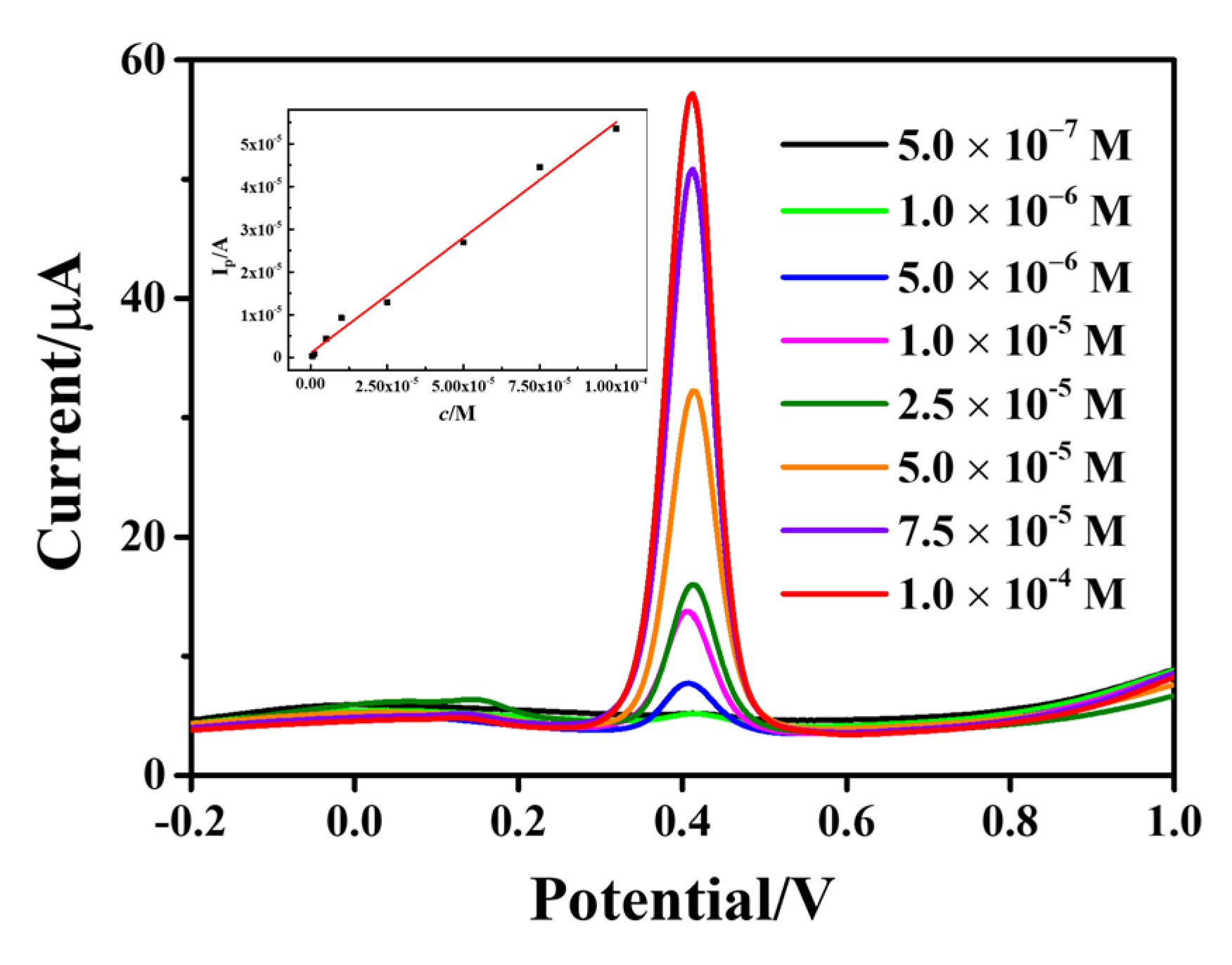

| Samples | Added (µM) | Found (µM) | Recovery (%) | RSD (%) |
|---|---|---|---|---|
| Tablet 1 | 10 | 27.47 | 101.43 | 1.39 |
| Tablet 2 | 20 | 37.68 | 100.67 | 1.14 |
| Tablet 3 | 30 | 47.58 | 100.52 | 0.32 |
Disclaimer/Publisher’s Note: The statements, opinions and data contained in all publications are solely those of the individual author(s) and contributor(s) and not of MDPI and/or the editor(s). MDPI and/or the editor(s) disclaim responsibility for any injury to people or property resulting from any ideas, methods, instructions or products referred to in the content. |
© 2023 by the authors. Licensee MDPI, Basel, Switzerland. This article is an open access article distributed under the terms and conditions of the Creative Commons Attribution (CC BY) license (https://creativecommons.org/licenses/by/4.0/).
Share and Cite
Shen, L.; Dong, J.; Wen, B.; Wen, X.; Li, J. Facile Synthesis of Hollow Fe3O4-rGO Nanocomposites for the Electrochemical Detection of Acetaminophen. Nanomaterials 2023, 13, 707. https://doi.org/10.3390/nano13040707
Shen L, Dong J, Wen B, Wen X, Li J. Facile Synthesis of Hollow Fe3O4-rGO Nanocomposites for the Electrochemical Detection of Acetaminophen. Nanomaterials. 2023; 13(4):707. https://doi.org/10.3390/nano13040707
Chicago/Turabian StyleShen, Lazhen, Jinlong Dong, Bin Wen, Xiangping Wen, and Jianhui Li. 2023. "Facile Synthesis of Hollow Fe3O4-rGO Nanocomposites for the Electrochemical Detection of Acetaminophen" Nanomaterials 13, no. 4: 707. https://doi.org/10.3390/nano13040707
APA StyleShen, L., Dong, J., Wen, B., Wen, X., & Li, J. (2023). Facile Synthesis of Hollow Fe3O4-rGO Nanocomposites for the Electrochemical Detection of Acetaminophen. Nanomaterials, 13(4), 707. https://doi.org/10.3390/nano13040707





